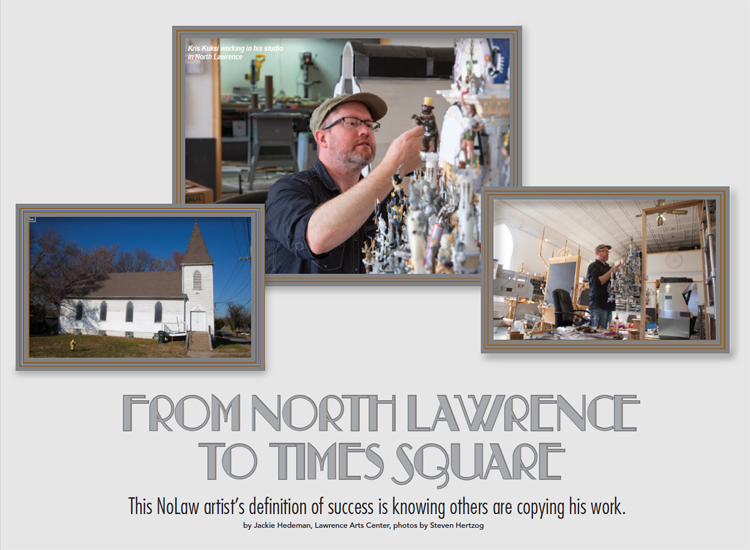This NoLaw artist’s definition of success is knowing others are copying his work.
| 2018 Q4 | story by writer Jackie Hedeman | photos by Steven Hertzog

I sometimes envy artists their studios. True, I don’t have to budget for rent or maintenance of the various coffee shop tables where I write, but I also miss out on the experience of allowing my brain its natural expansiveness. I don’t need a studio, but I wouldn’t mind plotting across four walls.
Kris Kuksi needs his studio, the former home of the St. James African Methodist Episcopal Church, located at Seventh and Maple streets, in North Lawrence. Built in 1897, the church has undergone renovations. Gone are the stained glass windows, which were broken prior to when Kuksi moved into the space. There is a choir loft, which is used for storage. The rest of the space is painted a bright, inviting white, a blank canvas for Kuksi’s work.
The space is gently cluttered, with pieces in various stages of completion arrayed on walls, against measurement grids, on tables and, in the case of one in the very early stages, spread out across the floor. Kuksi works in a variety of mediums and draws from a range of artistic and nonartistic influences, such as rococo and “human psychology.” Most striking are his assemblages: massive, intricate installations built from found and collected objects. One wall near the entry is dedicated to housing these objects, toy soldiers and picture frames, and tiny Doric columns.
The assemblages come together one element at a time, storytelling piece by piece. Sometimes, the thing Kuksi had in mind when he begins a piece will become something completely different at the end.
“I’m having that currently with this one,” he explains. He directs my attention to a mostly completed piece behind me. “I went to put that face down there on it. And I put it on there, and I loved it.”
But the gallerist thought it was “a little aggressive,” that it might reduce the number of clients willing to make a purchase.
He explains, “I tried other things, because I want to feel good about the piece. But I felt good with that face on there.”
The demands of creative expression and of the market are never easy forces to balance, least of all when your outlook comes with a sharp streak of realism, as Kris Kuksi’s does. “I hate that collision, because it’s compromise,” he says. Nonetheless, there is an element of adventure in creation with constraints. There’s the new T.I. album, for instance.
“What? Like, T.I., T.I.?” one might ask.
Yes. Kris Kuksi was commissioned to create the album artwork of Atlanta rapper T.I.’s 10th studio album “Dime Trap.” It’s plastered all over Times Square and was the first piece Kuksi built in 3-D software, “because of the time constraint,” he explains. “And now I have to build it for real, to go into his trap music museum.”
This seems like a far cry from the Lawrence Arts Center galleries, where I first saw Kuksi’s art. But then again, his work is featured in conventional and unconventional spaces. “I want to be where I’m not supposed to be. I’m not supposed to do rap covers,” he explains. “I did a big commission for the Marine Corps as part of a new recruitment program last year. It’s just all about visibility.”
Nonetheless, there is an ideal exhibition space: “I have a gallerist in New York who shows my work—it’s been about six or so solo shows—and he’s got a ground level huge space. That’s where an artist wants to be.”
What about audience?
“The young goths just love it. That’s evident on social media, with the likes. Then I have Mark Parker, the Nike CEO, he’s my biggest collector. Then I have some actors, comedians, musicians. They’re all over the board.”
This impresses me, though it doesn’t surprise me. Kris Kuksi’s work is incredibly specific, both in its detail and in its fidelity to his interests and vision. But like all good art, it also reflects back something of the viewer. That, to me, seems like success.
“My whole collector base is less than 100 people. It’s a really bizarre thing, because popularity doesn’t equate to success. I tell people that the definition of success is when people copy you. That’s when you know you’ve made your mark, you’re a trendsetter, you’ve done something right … But then, doing something with T.I., with a giant billboard in Times Square, that seems like I’ve made it.”
Working as a full-time artist for 11 years feels both stable and “as though the art market could come crashing down at any moment. “For 11 years, I haven’t known how much money I’m going to get or when I’m going to get it, but I seem to be able to keep going.”
This forward momentum is everywhere evident in this old North Lawrence church. There’s something contagious about Kuksi’s studio, with all its evidence of creation in progress despite, or perhaps because of, the fact that he doesn’t own any of his own art. (“It just feels selfish,” he says. “It’s not for me. It should be somewhere else. It’s for humanity.”) Because of this, or perhaps alongside this, there is heartbreak involved with endings, with declaring a piece done: “You don’t want to finish because this is living. This is it,” he says.
